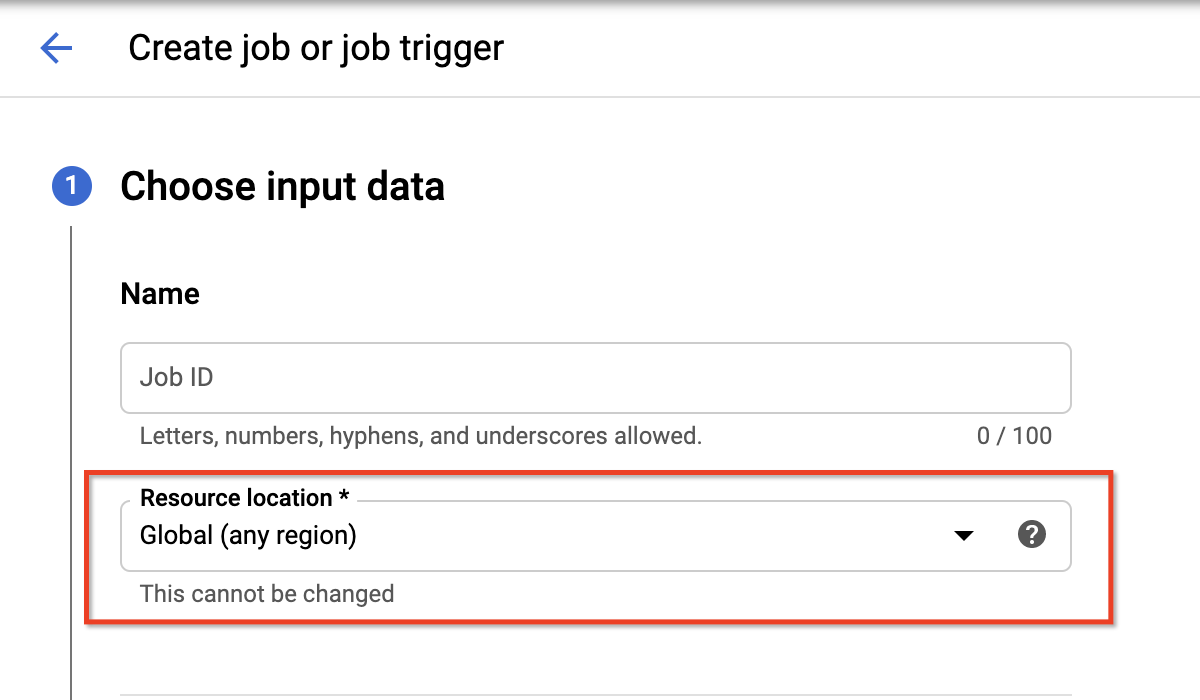通过指定要在其中执行 Sensitive Data Protection 操作的区域,您可以控制潜在敏感数据的处理位置。本文档介绍了 Sensitive Data Protection 处理位置的概念,并向您展示如何指定区域。
如需查看受支持的区域和多区域列表,请参阅 Sensitive Data Protection 位置。
关于区域和多区域
区域是特定的地理区域,例如美国西部或东北亚。多区域位置(或简称“多区域”)是包含两个或更多地理区域的大型地理区域,例如欧盟。
位置注意事项
适合的位置可让延迟时间、可用性和带宽费用之间取得平衡。
使用单区域有助于优化延迟时间和网络带宽。
如果您希望在 Google 网络外部处理数据并将数据分布在大型地理区域,或者您希望数据具备跨区域冗余性,进而实现更高的可用性,请使用多区域。
通常情况下,您应在方便或包含大部分数据用户的位置处理数据。
如果您的组织需要将传输中的数据保留在指定位置,请仅使用支持区域端点 (REP) 的区域或多区域。在这种情况下,您需要使用 Cloud Data Loss Prevention API,因为敏感数据保护的区域端点无法与Google Cloud 控制台搭配使用。
指定一个区域
指定处理区域的方式取决于您要将请求发送到的端点类型,即全球端点或区域端点。您选择的端点类型取决于您是否需要将传输中的数据保留在指定区域内。如需了解详情,请参阅敏感数据保护的全球端点和区域端点。
在向全球端点发出的请求中指定区域
控制台
请在设置 Sensitive Data Protection 操作时选择一个区域。
例如,创建作业触发器时,请从资源位置菜单中选择一个位置,如下所示:

如果您无需担心处理位置,请使用全球区域,Google 会选择处理位置。全球是默认区域选择。
REST
在请求端点网址中插入区域信息。如果您无需担心处理位置,请使用 global 区域,Google 会选择处理位置。请注意,指定 global 区域的请求创建的所有资源都存储在 global 区域下。
以下是一些向全球端点发出的请求示例。
使用全球区域
以下两个请求具有相同的效果。不包含区域与指定 locations/global/ 相同。
POST https://www.googleapis.com/dlp/v2/projects/PROJECT_ID/locations/global/content:inspect
POST https://www.googleapis.com/dlp/v2/projects/PROJECT_ID/content:inspect
使用特定区域
要指定处理区域,请在资源网址中依次插入 locations/ 和区域名称。
POST https://www.googleapis.com/dlp/v2/projects/PROJECT_ID/locations/us-west2/content:inspect
在向区域端点发出的请求中指定区域
控制台
对于 Sensitive Data Protection,区域级端点无法与 Google Cloud 控制台搭配使用。
C#
如需了解如何安装和使用 Sensitive Data Protection 客户端库,请参阅 Sensitive Data Protection 客户端库。
如需向 Sensitive Data Protection 进行身份验证,请设置应用默认凭据。如需了解详情,请参阅为本地开发环境设置身份验证。
Go
如需了解如何安装和使用 Sensitive Data Protection 客户端库,请参阅 Sensitive Data Protection 客户端库。
如需向 Sensitive Data Protection 进行身份验证,请设置应用默认凭据。如需了解详情,请参阅为本地开发环境设置身份验证。
Java
如需了解如何安装和使用 Sensitive Data Protection 客户端库,请参阅 Sensitive Data Protection 客户端库。
如需向 Sensitive Data Protection 进行身份验证,请设置应用默认凭据。如需了解详情,请参阅为本地开发环境设置身份验证。
REST
以下示例会向区域端点发送 content.inspect 请求。与此请求关联的所有数据在传输、使用和静态存储期间都将保留在指定区域中。
在使用任何请求数据之前,请先进行以下替换:
-
REP_REGION:Sensitive Data Protection 的区域端点 (REP) 可用的区域,例如us-west2。如需查看完整的区域列表,请参阅 Sensitive Data Protection 位置。 -
PROJECT_ID:您的 Google Cloud 项目 ID。 项目 ID 是字母数字字符串,例如example-project。
HTTP 方法和网址:
POST https://dlp.REP_REGION.rep.googleapis.com/v2/projects/PROJECT_ID/locations/REP_REGION/content:inspect
请求 JSON 正文:
{
"inspectConfig": {
"infoTypes": [
{
"name": "CREDIT_CARD_NUMBER"
}
]
},
"item": {
"value": "hi, my ccn is 4111111111111111"
}
}
如需发送您的请求,请展开以下选项之一:
您应该收到类似以下内容的 JSON 响应:
{
"result": {
"findings": [
{
"infoType": {
"name": "CREDIT_CARD_NUMBER",
"sensitivityScore": {
"score": "SENSITIVITY_HIGH"
}
},
"likelihood": "LIKELY",
"location": {
"byteRange": {
"start": "14",
"end": "30"
},
"codepointRange": {
"start": "14",
"end": "30"
}
},
"createTime": "2024-08-09T19:54:13.348Z",
"findingId": "2024-08-09T19:54:13.352163Z4747901452516738787"
}
]
}
}主机托管注意事项
扫描 Cloud Storage 或 BigQuery 等存储区时,应在 Sensitive Data Protection 请求中指定与要扫描的存储区相同的位置。例如,如果 BigQuery 数据集位于欧盟多区域位置,请在配置 Sensitive Data Protection 作业时指定欧盟多区域 (europe)。
如果您未将敏感数据保护请求与要扫描的存储区设在同一位置,则可能会在数据位置和请求中指定的位置之间拆分请求。
后续步骤
- 详细了解地理位置和地区。
- 请参阅支持的区域和多区域列表。
- 详细了解 Sensitive Data Protection 的全球和区域端点。

